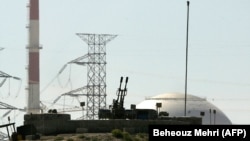While the parliament weighs President Hassan Rouhani's budget for the new Iranian year (beginning March 21), senior officials at the Atomic Energy Organization of Iran (AEOI) have complained of the "minimal" budget allocated to the Bushehr nuclear power plant.
The head, deputy head, and spokesman for AEOI have all criticized the government, saying the budget allocated to the plant in southern Iran is so low that it endangers the future of the nuclear reactor.
The Energy Ministry “pays peanuts” for electricity produced at Bushehr, AEOI and former Foreign Minister Ali Akbar Salehi said on February 23. "For each kilowatt per hour of electricity produced at Bushehr, ME pays half a cent but exports electricity for nine cents," he said.
Speaking at an industrial seminar, Salehi said, "The electricity produced at Bushehr reactor is bought for $40 million, while the annual budget needed for running the plant is $120 million. There’s a deficit of $80 million for which we don’t know how to compensate."
Iran is currently suffering from an acute economic crisis and has been unable to issue a budget for the upcoming Iranian fiscal year. U.S. economic sanctions have halved Iran's oil exports, which provide the hard currency needed for government operations.
AEOI spokesman Behrooz Kamalvandi says that given the budget allocated to Bushehr, the fate of Iran's only nuclear power plant now hangs in the balance.
Bushehr’s construction started during the reign of Shah Mohammad Reza Pahlavi in 1975 by Kraftwerk Union, a Siemens company, along with several other German firms.
Following the downfall of the monarchy, work on the nuclear reactor ground to a halt.
A veteran Iranian diplomat and former foreign minister, Abbas Khalatbari, was executed by firing squad in April 1979 for charges that included signing a contract with Germany for the power plant’s construction.
However, in 1988, Russia signed a contract with Iran to complete the project.
After years of delays, the power station finally went online and was connected to Iran's national grid in September 2011, generating electricity at 40 percent capacity. The plant reached its maximum power generation capacity of 1,000 megawatts in August 2012.
This marks the first time that high-ranking officials have called Bushehr a "loss-making" project. But, in reality, the government pays a small price for electricity generated by the reactor and then makes more than $500 million profit from exporting it.
The controversial budget for Bushehr, along with Iran's rapidly devaluating national currency, has endangered the fate of the nuclear reactor, AEOI deputy head Mohammad Ahmadian acknowledged on February 21.
The only way to save the nuclear plant, AEOI officials say, is for the government to pay for its electricity at the same rate as exports.
Based on a parliamentary motion endorsed by the parliament 14 years ago, the Iranian government is obliged to construct 13 more plants with output similar to Bushehr’s.
Opponents have long insisted that since Iran is rich in oil and natural gas resources and poor in uranium ore deposits, the viability of its nuclear program is questionable.
Based on assessments by the IAEA, the World Nuclear Association, and the International Energy Agency, nuclear power plants cannot compete with fossil fuel power stations in countries that are rich in oil and gas.
In the United States, for example, as one of the largest producers of natural gas, running natural gas power plants costs approximately 20 percent less than operating nuclear plants.





